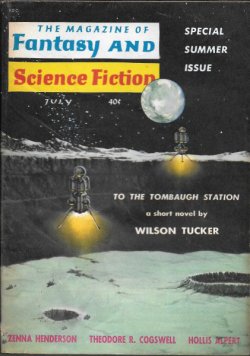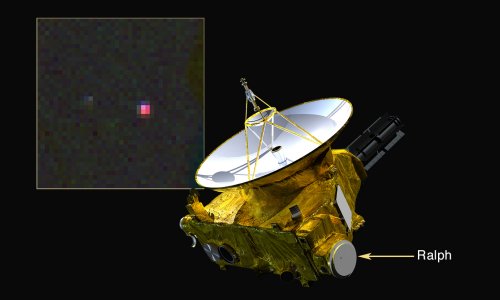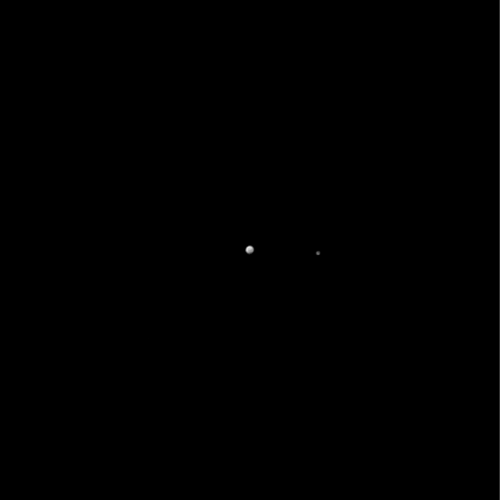
As I write, we’re thirteen and a half days out from the Pluto/Charon encounter. New Horizons will make its closest approach to Pluto at 0749 EDT (1149 UTC) on July 14. All of which has had me reading Pluto-related science fiction that I missed along the way, including most recently Wilson Tucker’s “To the Tombaugh Station.” The story, which ran in the July, 1960 issue of Fantasy and Science Fiction, is a murder investigation that includes a journey to the station of the title, which had been established to investigate a ‘Planet X’ still further out in the system. Isaac Asimov has an essay on Pluto in this issue as well.
Image: The cover of the July, 1960 Fantasy and Science Fiction shows a generic moon landing scene by artist Mel Hunter. But if you look at it with our post-1978 (discovery of Charon) eyes, it could be seen as an imaginative take on a Pluto landing, with the Earth on the horizon being replaced by Charon. Given the prominence of “To the Tombaugh Station” on the cover, I found myself doing a double-take.
As to the real Pluto, we now learn that the infrared spectrometer on New Horizons has detected frozen methane on the surface, a compound first observed on the dwarf planet as early as 1976. What New Horizons will bring to the table is the chance to study differences in methane ice from one part of the surface to another. According to this NASA news release, Dale Cruikshank (NASA Ames, and a member of the New Horizons team) led the team of ground-based astronomers that made the original methane detection.

Image: The location of the New Horizons Ralph instrument, which detected methane on Pluto, is shown. The inset is a false color image of Pluto and Charon in infrared light; pink indicates methane on Pluto’s surface. Credit: NASA/Johns Hopkins Applied Physics Laboratory/Southwest Research Institute.
I hope you’re taking advantage of the fact that the raw images from New Horizons are being made available on the JHU/APL website. There you can see images from the spacecraft’s Long Range Reconnaissance Imager (LORRI) displayed without special processing. They’re posted within about 48 hours after coming in to the New Horizons Science Operations Center.
And below is the latest time-lapse movie, this one showing changes in the apparent size of Pluto and Charon as the spacecraft moves from 56 million kilometers to 22 million kilometers. The images involved in this time-lapse approach movie were taken between May 28 and June 25. Pluto continues to show a surface marked by a bright northern hemisphere, with darker material in a discontinuous band along the equator. It’s exciting to see differences emerging on Charon as well, along with the previously noted dark polar region.

The short video below is an annotated version of the above in which Pluto’s prime meridian (the region of the planet that faces Charon) is shown in yellow and the equator is shown in pink.
New Horizons’ Alice ultraviolet imaging spectrograph performed a test observation of the Sun on June 16 (this from a distance of 5 billion kilometers) to use in the interpretation of atmospheric observations to be taken on July 14. On that day, not long after the Pluto flyby, the spacecraft will study sunlight as it passes through Pluto’s atmosphere. New Horizons scientist Randy Gladstone (SwRI) puts it well: “It will be as if Pluto were illuminated from behind by a trillion-watt light bulb.” That backlight will tell us much about the atmosphere’s composition.
A thruster burn beginning at 1101 EDT (1501 UTC) on June 29, stopping 23 seconds later, was used to make the smallest of the nine course corrections since the spacecraft’s launch in 2006. New Horizons changed velocity by 27 centimeters per second, making a slight adjustment to its arrival time and position at close approach and flyby. The difference upon arrival: The craft would have reached close approach 20 seconds late without the burn, and 184 kilometers off-target.
“This maneuver was perfectly performed by the spacecraft and its operations team,” added mission principal investigator Alan Stern, of Southwest Research Institute, Boulder, Colorado. “Now we’re set to fly right down the middle of the optimal approach corridor.”



Yes, I have that 1960 issue of F&SF (my own first cover was 1971 — look out for a new one later this year) and agree — it could be Pluto and Charon!
On the Final Path: New Horizons Executes Last Course Correction Maneuver Prior to Pluto Closest Approach
By Leonidas Papadopoulos
With just under two weeks remaining for its close flyby of the Pluto system on July 14, NASA’s New Horizons spacecraft has swung into full action in preparation for the historic event. As part of its pre-scheduled approach phase activities, the intrepid robotic explorer successfully conducted its final course correction maneuver, which put it right on top of the trajectory required for its upcoming close passage through the Pluto system.
This final course correction maneuver involved a 23-second burn of the spacecraft’s thrusters, which took place on 11:01 p.m. EDT on June 29 and was just the third for New Horizons following the beginning of its long-range reconnaissance of Pluto in January, after a 93-second burn on March 10 and another 45-second burn on June 14.
The result of this latest highly accurate burn was to alter New Horizons’ velocity by a miniscule 27 centimeters per second, which might seem like an extremely small change, but will have a significant effect on the spacecraft’s trajectory nevertheless, without which New Horizons would have arrived 20 seconds late on Pluto and 184 km off target during the day of closest approach.
“This maneuver was perfectly performed by the spacecraft and its operations team,” says Dr. Alan Stern, principal investigator for the New Horizons mission, at the Southwest Research Institute, in Boulder, Colo. “Now we’re set to fly right down the middle of the optimal approach corridor.”
Full article here:
http://www.americaspace.com/?p=83802
Nailbiting stuff!
Go New Horizons.
I’ve been oggling the RAW images too and thanks to the image-processing (stacking) being performed by enthusiasts over on Unmanned Spaceflight dot com we’re being constantly fed new and exciting imagery. Truly a thrilling ride to be able to follow along with.
Pluto article by Frank Drake’s daughter in the July, 2015 issue of National Geographic Magazine, online here:
http://ngm.nationalgeographic.com/2015/07/pluto/drake-text
Three possible scenarios for the surface geology of Pluto:
http://ngm.nationalgeographic.com/2015/07/pluto/landscapes-graphic
It’s amazing to see Charon already with more resolution than we had of Pluto before the voyage.
It bothers me to absolutely no end to see that herky-jerky motion picture of Pluto’s moons circling Pluto. I prefer a still picture rather than this artificial movie that they keep pushing on everybody
The Science of Pluto: The Gates of the Planetary Underworld (Part 1)
By Leonidas Papadopoulos
http://www.americaspace.com/?p=84026
After Glitch, New Horizons to Resume Science Operations July 7, Before Pluto Encounter
By Paul Scott Anderson
http://www.americaspace.com/?p=84028
A 2015 review of the June, 1960 Fantasy and Science Fiction magazine issue featured in this article:
http://galacticjourney.org/?p=505
Thank you for this pleasant intersection of science fact and fiction.
July 1960 is like yesterday to me (literally)! I reviewed the entire issue pictured above, including the Tucker story, last month:
http://galacticjourney.org/?p=505
I also summarized our knowledge (or lack thereof) of the “9th Planet” the week before:
http://galacticjourney.org/?p=472